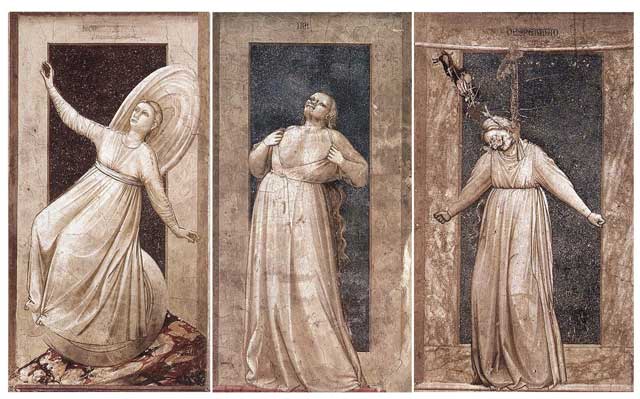Great works: Vices (1303-6), Giotto
Scrovegni Chapel, Padua

There is a short poem by Bertolt Brecht, "The Mask of Evil".
"On my wall hangs a Japanese carving,
The mask of an evil demon,
decorated with gold lacquer.
Sympathetically I observe
The swollen veins of the forehead,
indicating
What a strain it is to be evil."
It comes to a surprising conclusion. The usual roles are reversed. The observer looks on, not with fear or excitement, but with calm compassion. The monster is in pain. If only evil could escape from its strenuous mission.
This is not the normal lesson. No, the devil has all the best tunes, or so they say, and his followers have all the fun. We'd all do it, if we dared. Don Juan: exploitation. Faust: power. Cain: murder. But we don't dare, so we make myths and heroes out of these diabolical figures, and ourselves knuckle down to caution and morality. Satan himself, the great rebel, is the archetype of romance. He and his demonic gang are models of strength, energy, freedom, resourcefulness, charisma. The rest of us are weak, insipid, enviously dull. And in stories it's the same. The good are lifeless. The bad are inevitably adventurous. Etc. Etc.
So Brecht is wise, helping us to see through the appearance of masterful strength to an imprisoning strain. And Simone Weil is clear too, illuminating the difference between fact and fiction. "Nothing is so beautiful and wonderful, nothing is so continually fresh and surprising, so full of sweet and perpetual ecstasy, as the good. No desert is so dreary, monotonous, and boring as evil. This is the truth about authentic good and evil. With fictional good and evil it is the other way round. Fictional good is boring and flat, while evil is varied and intriguing, attracting, profound, and full of charm."
But if that is true, it's not exclusively true. There are some images that portray evil with an utter lack of charm or variety. Milton's Satan may have a touch of the super-hero, but look back to Dante's Inferno. At the centre of this hell you find a very different Satan: vast, immobile, frozen in ice, unceasingly weeping, and chewing on sinners like a mill. As a devil, he's suffering from something worse than strain. As a character, he's frankly a disappointment. Pure evil is pure monotony.
Giotto was Dante's near contemporary. His frescoes in the Scrovegni Chapel were painted shortly before Dante's Inferno was begun. They have a big Last Judgement at the end, with three tiers of scenes on the walls, illustrating the lives of Jesus and his forebears. But there is another row, almost at floor level, with 14 individual figures spaced out: seven Virtues and seven Vices.
The Virtues are standard. There are three theological Virtues, Hope, Faith and Charity, and four classical Virtues, Justice, Wisdom, Fortitude and Temperance. But the Vices are not the now-familiar Seven Deadly Sins. Giotto's cast is more closely paired with the seven Virtues. He pictures Despair, Infidelity, Envy, Injustice, Folly, Inconstancy and Anger. Three are shown here: Inconstancy, Anger, Despair.
When you compare them, Virtues against Vices, the comparison is clear and as expected. The Vices do have better tunes. They are obviously more interesting figures. The Virtues are serene, upstanding, solid. The Vices are passionate, animated, dramatic. Giotto's pictorial devices actually work for them. The 14 figures are all painted like statues, carved in stone, standing in niches. Each of them, Virtue or Vice, has a physical fortitude, imbued by its stone nature.
But the Virtues are like statues anyway. Their static medium is only confirmed by their static characters. They are already stone-still, fixed in their niches. The Vices have a dramatic tension between their medium and their action. Their niches become little theatres, in which they appear before us, throwing themselves into convulsions.
Look at Inconstancy, a wildly careering acrobat. She rides a wheeling disc, and tries to keeps herself rolling and upright, with wavering arms holding her swinging balance, while she teeters on a sloping floor, a jacked-up triangular surface, made of inlaid marble. Her circular fling of garment echoes the whirl of her wheel and creates a cartoon-motion effect.
Despair has hanged herself with a scarf from a bending crossbar on her niche, caught at the moment of suicide, dropping like deadweight. She has despaired of salvation. She is going straight to hell. A little devil swoops down to carry away her soul. This figure has literally provoked an audience response. Iconoclasm! Her head and her devil have been vandalised, scratched out, defaced – a recognition that this evil is intolerable, and must be obliterated.
But Anger is the most powerful invention. See how this woman stretches herself out, wrenches open her dress, forcing it – at first you don't see the shape – into an outlined rectangular void over her heart. Her face smarts from the harm her feelings are doing. There is no sense of her fury being directed outwards, as malevolence or cruelty. It is all internalised. She's tearing herself apart.
Giotto's Vices are studies in self-destruction. They are not boring, no, but nor are they heroes or rebels or charmers. They have nothing of power or attraction. They are helpless, raging creatures. Their isolated poses show their doom. Their deep damage is only doing to themselves. Evil always gets its perpetrators. Psychology – medieval or modern – teaches that. But a waiting hell probably helps too.
ABOUT THE ARTIST
Giotto di Bondone (c1267-1337) is the founder of European painting. The Florentine introduced emotional power and 3D realism. An early commentator said he "translated the art of painting from Greek into Latin", ie from flat Greek-Byzantine icons to solid Roman statues.
Subscribe to Independent Premium to bookmark this article
Want to bookmark your favourite articles and stories to read or reference later? Start your Independent Premium subscription today.

Join our commenting forum
Join thought-provoking conversations, follow other Independent readers and see their replies